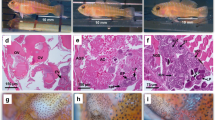Abstract.
To investigate the relative cost of protogynous versus protandrous sex change we induced sex change in each direction in Gobiodon histrio (Gobiidae) and then compared growth, body condition and biochemical condition between sex-changed and non-sex-changed fish in treatment and control groups. Sex change in each direction was induced by establishing pairs of adult males and pairs of adult females on isolated coral colonies. Heterosexual pairs were used as controls. For both males and females, growth and body condition did not vary between fish that changed sex and those that did not. The relatively low cost of sex change, compared to the likely costs of searching for a mate of the correct sex, appears to explain the evolution of bi-directional sex change in coral-dwelling gobies. Lipid concentrations in the liver of males and females that changed sex were reduced by similar amounts (34% and 41%, respectively) compared to male and female controls that did not change sex. Therefore, changes in biochemical condition were approximately equal for fish that sex change in each direction and cannot explain the unequal frequency of sex change in each direction in natural populations of G. histrio.
Similar content being viewed by others
Author information
Authors and Affiliations
Additional information
Electronic Publication
Rights and permissions
About this article
Cite this article
Munday, .P., Molony, .B. The energetic cost of protogynous versus protandrous sex change in the bi-directional sex-changing fish Gobiodon histrio . Marine Biology 141, 1011–1017 (2002). https://doi.org/10.1007/s00227-002-0904-8
Received:
Accepted:
Issue Date:
DOI: https://doi.org/10.1007/s00227-002-0904-8




